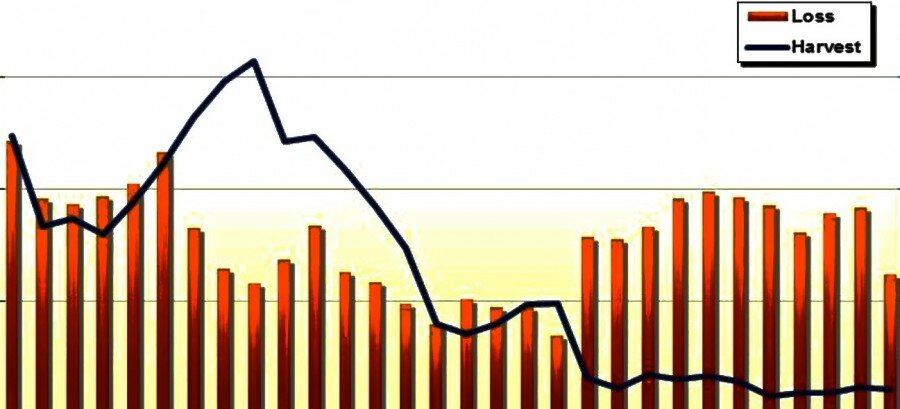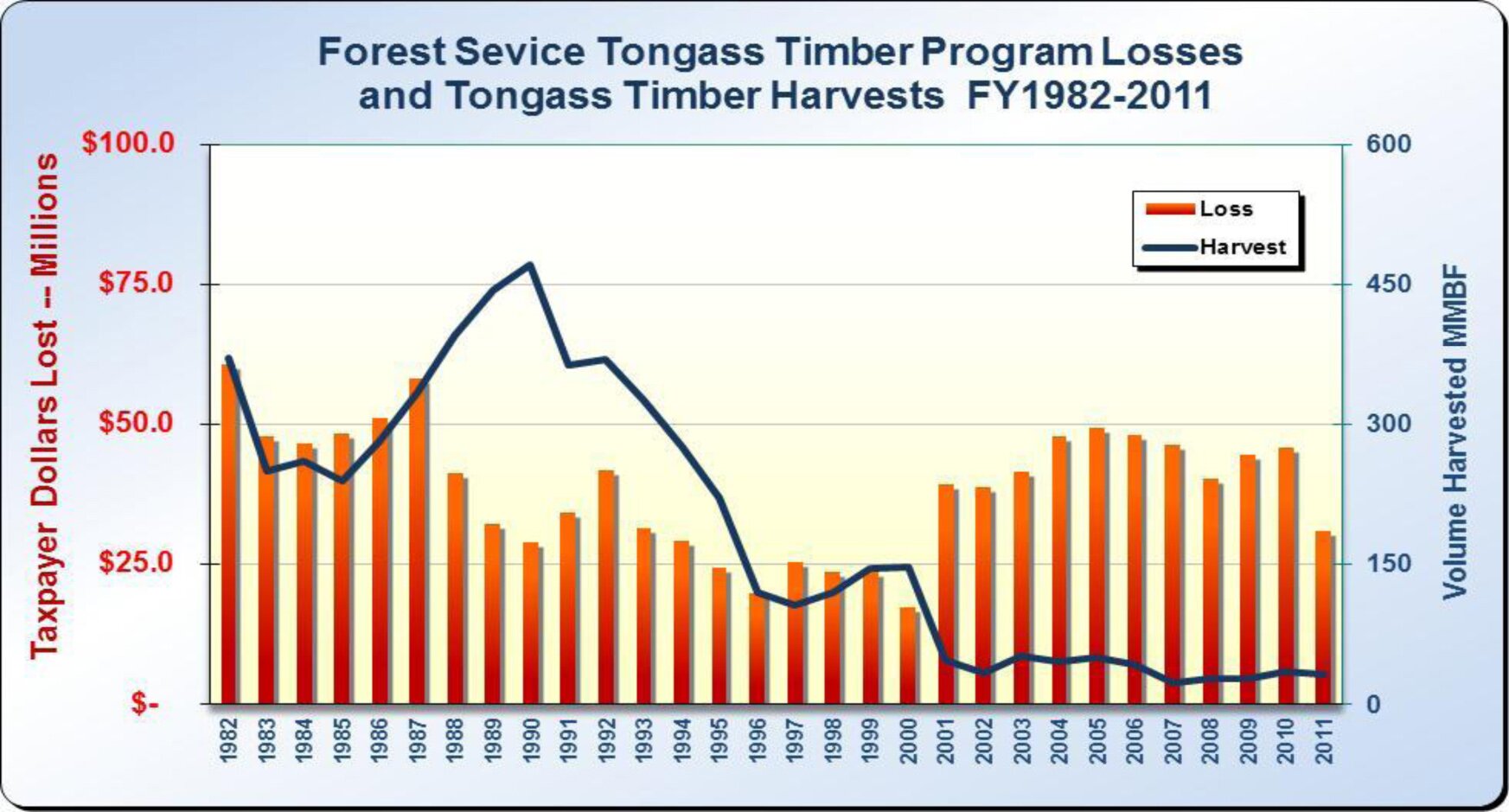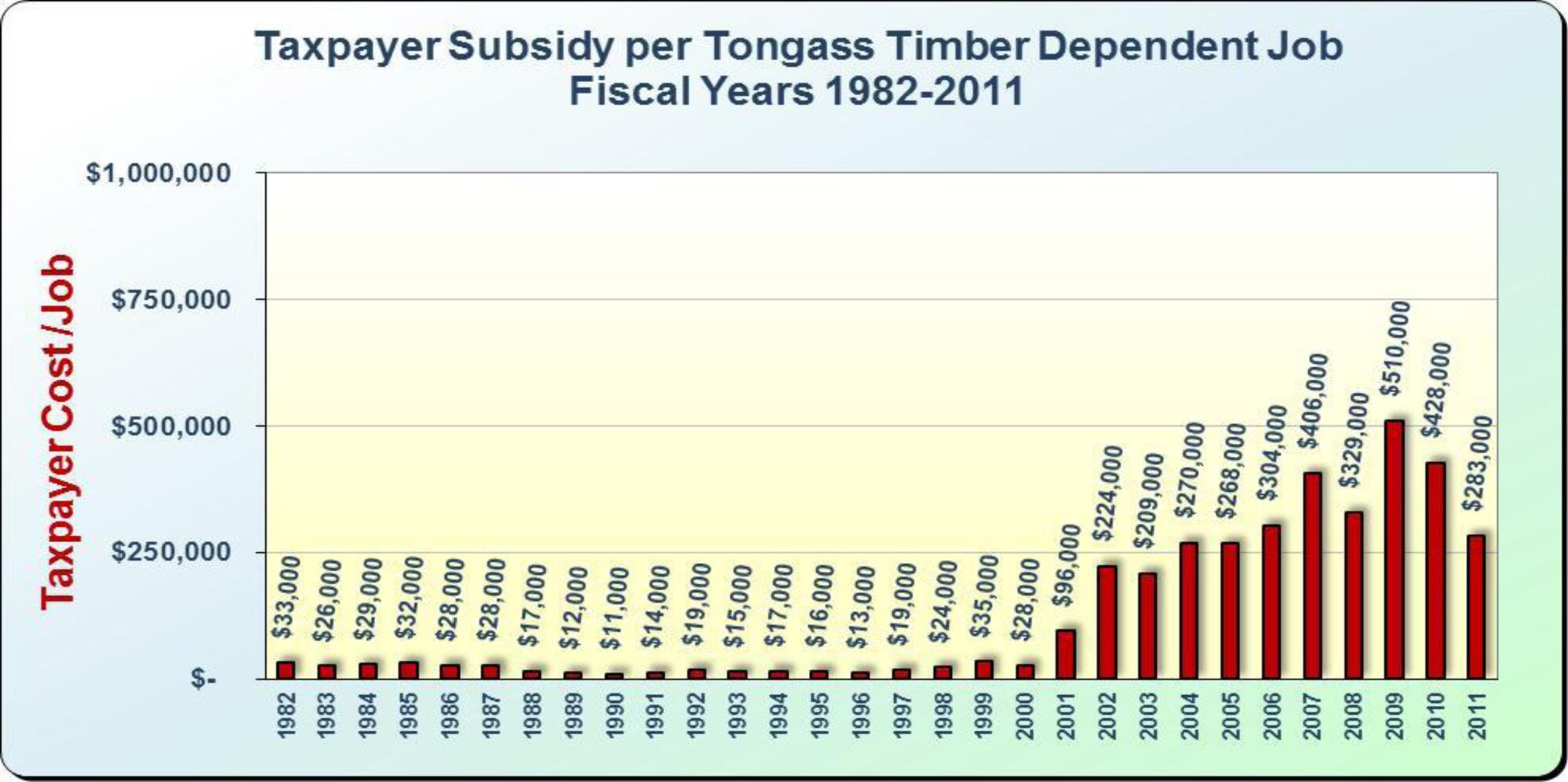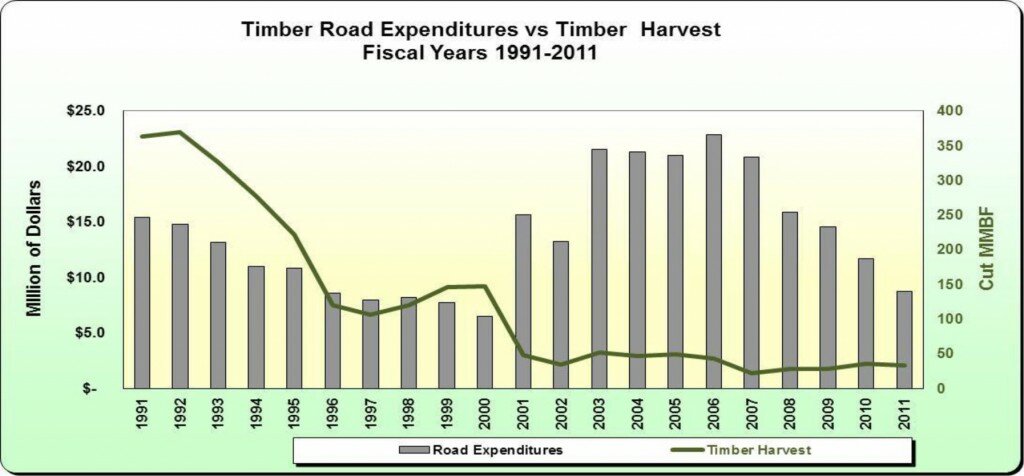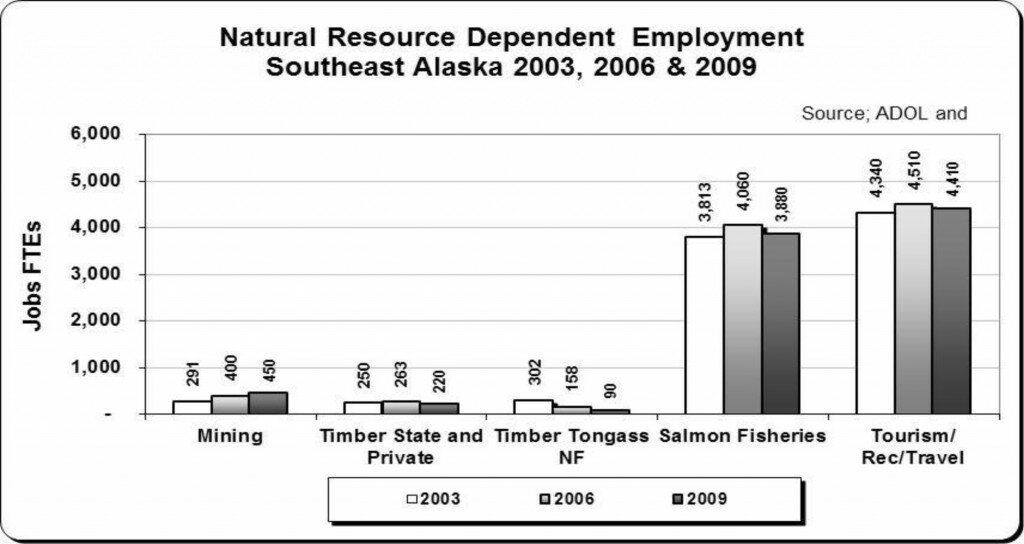By Joseph R. Mehrkens (retired USFS economist)
Last revised: 4/20/2013
This paper is designed as a briefing paper. Future revisions and additions will periodically occur. It will be available on the Greater Southeast Alaska Conservation Community website gsacc.net. It is the sole product of J.R. Mehrkens and is based primarily on Tongass information collected since 1977 and organized into a series of Excel Spreadsheets.
Introduction: It is well known that the Tongass timber program is a real money loser. The GAO (federal Government Accountability Office) found in the late 1990s that the Tongass timber program lost 80-94 cents on every dollar spent. The loss is far worse today – especially with the new wrinkle where the Forest Service uses old-growth timber sale revenues to finance even greater money losing activities, e.g., stewardship/restoration contracts. In essence, this means more old growth is logged to ostensibly repair past old growth logging and to create more potential restoration projects.
While forest restoration is a good goal, there are far superior ways to pay for it. However, first it’s important to revisit some of the basic underlying issues of Tongass timber economics such as taxpayer losses, the steep decline in timber demand and the high costs for logging roads (the greatest contributor to taxpayer losses).
In economic analysis there are two primary tasks: (1) identifying the stream of costs and benefits over time to determine if benefits exceed costs, and (2) identifying who benefits from and who pays for the project. To date all of the Tongass restoration projects (proposed or in-progress) have done neither.
Tongass Timber Losses
Figure 1 shows the taxpayer loss (implicit subsidy) to make Tongass timber available and support local jobs in the timber industry. The losses in Figure 1 are contrasted with the declining trend in Tongass timber harvests (timber demand) since 1989.
Figure 1
Figure 2 shows that back in the heydays, taxpayers paid a subsidy of $12,000-$36,000 per Tongass timber job or, put another way, somewhere between 50%-100% of what a person could earn in the timber industry. However, over the last decade the subsidy has grown to a staggering $224,000 to $510,000 per job – a nearly 1,400% increase. How can that be? The Forest Service kept spending like the industry was in its heyday while the industry was in a persistent long-term decline. It is as simple as that.
Figure 2
To summarize: the high and persistent timber program expenditures minus declining timber sale revenues are the losses shown in Figure 1. Figure 2 simply translates these losses and the associated decline in timber employment into lost taxpayer dollars per timber job.
(Special note: To the Forest Service’s credit Tongass timber program expenditures have decreased in recent years, but the fact remains that the Forest Service is still chasing after fewer and fewer timber jobs so that the subsidy per job remains extraordinarily high – at least a 13 fold increase from a decade ago.)
Expenditures for road building are some of the largest contributors to the Tongass losses. Figure 3 shows that engineering support and road building expenditures are as high now as they were during the pulp mill era despite an 88% reduction in timber harvests since 2001. Tongass roads are some of the most expensive in the National Forest system and unfortunately many of these investments were deliberately not maintained. Ironically, today these neglected roads are now a major focus of the stewardship/restoration contracts.
Figure 3
While the above timber and road losses are staggering in themselves, they are now a prerequisite for most of the stewardship contracting expenditures. Why? ⎯ because recent policy changes allocate old-growth timber revenues as a primary funding source for stewardship projects. This arbitrary policy results in millions of dollars spent in the old-growth timber program before public dollars are available for stewardship contacting.
On a brighter note, for 2013 one million dollars has been pledged by some very generous NGOs and private foundations for Tongass stewardship projects. In light of these tough economic times, Southeast Alaska residents should be very grateful for this generosity. Despite this generosity, the federal taxpayer is also being forced to participate in stewardship contacting by the use of old-growth timber revenues as off-budget funding.
Sawmill Jobs Sacrificed To Create Restoration Jobs
Until recently, federal policy largely prohibited round log exports (except for cedar) in order to provide Tongass trees to create local jobs. Since the 1920’s the Forest Service has relentlessly tried to establish an industrial scale market for Tongass timber but never succeeded in a sustainable way. The 43-year pulp mill era is the epitome of this effort, and its unsustainability is at the heart of the problems the Tongass faces today. Alaska’s higher than average production costs have always made it vulnerable in very competitive global export markets – where nearly all Tongass timber products are sold. To overcome this competitive disadvantage, the Forest Service initially relied on (1) creating regional timber monopolies on the Tongass, (2) charging very low prices (stumpage) for Tongass timber, and (3) allowing loggers to take additional trees for free in order to build extensive logging roads.
Despite these efforts, the Tongass substantially began to lose global market shares in 1980’s and the agency had to find additional countermeasures such as building a portion of the logging roads with taxpayer monies (appropriated federal funds). The agency also reduced the price of timber already purchased by loggers and allowed timber purchasers to outright cancel their timber sales. Even this was not sufficient.
As the Tongass timber demand continued to deteriorate, the Forest Service finally decided to relax round log export restrictions — the very seminal timber policy adopted to create local jobs in the first place. Today up to half the volume of logged spruce and hemlock can be exported – at a direct loss of Tongass timber jobs.
Figure 4 shows the magnitude of each resource industry in the region’s economy. Given the small contribution by the timber industry one would assume that the budget for timber program funds would be reduced, or be reallocated to other forest-dependent industries, such as the commercial fishing and tourism. However, in terms of Forest Service annual expenditures, timber is still king.
Figure 4
Faulty Premises for Tongass Stewardship
The USFS uses two fundamental premises for its Tongass stewardship projects that are wrongheaded and disingenuous: (1) that using old-growth timber revenues to help pay for stewardship contracting is acceptable, and (2) that someday stewardship will be a source of sustainable, good paying jobs.
The heavy reliance on using timber sale revenues to support so-called stewardship is wrong headed on many levels. A combination of three factors will severely limit funding. First, the competitive position of future Tongass timber is very uncertain. Second, the best timber is already gone — most of which went to build an extensive and poorly maintained road system that the Forest Service now proposes to restore via stewardship. Third, Alaska’s big cost disadvantage remains and suggests that even fewer export restrictions are in the future – which itself has its own limits.
How did this come about? First, the Tongass timber industry has faced a competitive disadvantage since the early 1900’s. Second, the Forest Service has a 100-year history of using the timber industry as a universal hammer to “fix” everything. For example, the agency used three 50-year timber sale contracts to attract pulp mills to the region in the 1960’s. The contracts rewarded the timber industry by letting them take the very best timber at bargain basement prices – an activity known as high-grading. Also the 50-year contracts facilitated natural monopolies. Then, the Forest Service used something called purchaser credits to build the majority of the logging roads for the industry. The credits simply gave additional trees away in return for the timber purchaser to build the logging roads. In these ways, the timber industry and Forest Service targeted the better old growth first. For the industry it meant faster and greater profits. For the Forest Service it meant trading the higher quality trees, a gift of nature, to build the logging roads. This allowed the agency to bypass the fight to gain greater taxpayer dollars to build the logging roads, but more importantly to extend the logging roads as fast and as far as possible – beyond the initial logging areas.
Since Tongass roads are some of the most expensive in the National Forest System, it took a significant portion of the better timber just to finance the road system. Unfortunately, it was a higher priority to extend the roads into roadless areas than it was to maintain the roads already in place. The result is a large backlog of road repair and reconstruction. Now even more old-growth logging is supposedly needed to fund this work. Continuing this practice just piles new problems on top of the mountain of problems incurred from the past. The Forest Service is still stuck on using its favorite management tool ⎯ old growth logging ⎯ to create another “fix”.
To date, Tongass restoration work has been low tech, seasonal or part-time work. Its future will continue to be tied to federal contracting or appending stewardship contracting to old-growth timber sales. Currently the old growth timber industry is less than 1 percent of the private sector employment in southeast Alaska with a very uncertain future at best. Tying stewardship contracting to a struggling old-growth timber industry will not make it a base industry upon which to build a renewed regional economy.
The Tongass Transition Has No Clothes
The Forest Service and the Obama Administration have been foisting a new policy to “transition” the Tongass from old growth logging to a combination of second-growth logging and stewardship/restoration contracting. However, no feasibility studies or specific timelines have been specified. The only certain transition is a natural one, which will happen in about 30 years when the economic old growth in the timber base will be cut out. Until then, only a small portion of the previously cut lands will be mature enough to be logged as sawtimber. Notwithstanding these realities, there are other agendas to use immature second-growth for commodities such as wood pellets. However, overcoming Alaska’s production cost disadvantages in these new endeavors is an even greater uncertainty.
Whereas Alaska’s old-growth was a high value product that could be sold at a discount in order to compete with other suppliers, second-growth wood products (such as pellets), are lower value commodities and are produced by many lower cost competitors. For example, the value of pellets is so low it cannot underwrite the construction of pellet plants, manufacturing, or transportation to markets. Rough estimates indicate that a set of vertical, integrated subsidies are necessary as a sort of cradle to grave subsidy for plant construction, raw material supply, manufacturing, transportation to markets and perhaps a retail rebate.
In stark contrast to this reality, the Wilderness Society (TWS) recently released a study to promote a combined Tongass second-growth and restoration economy. Its conclusion was if the millions of dollars now spent to subsidize the old-growth timber industry were alternatively reallocated to a second-growth/ restoration industry, it would require a just slightly higher subsidy and provide nearly the same number of current jobs. More important, while the TWS proposal would supposedly cost a little more and provide slightly fewer jobs, it does not cite any economic feasibility studies to support their proposal.
Simply stated, the TWS advocacy of the transition highlights the fact that the transition to a second-growth based economy has no sound economic foundation, i.e., no economic feasibility studies. To date, the “economic analyses” of the transition rely on one very heroic assumption that the business ventures associated with it are indeed feasible and that is simply a matter of reallocating federal dollars from old-growth logging to the transition activities. This is false but feeds the illusion there is win-win solution for the timber industry and environmental groups commonly known as free market environmentalism.
The real proof of the dubious nature of the Transition policy’s feasibility comes from the timber industry. Ever since the Forest Service announced their new policy committing to the Transition, timber industry supporters have initiated their own studies on the existing inventory of the suitable 2nd-growth timber and the economic feasibility of 2nd-growth.
This skepticism is very well expressed by the operators of the Viking Lumber mill and is documented in a letter from Senator Murkowski to USDA Secretary Vilsack dated March 12, 2013. Her letter states: “Most recently Kirk Dahlstrom has made a new proposal saying that he could remodel a current small log processing line at his Klawock mill for a grant of just $1.5 million to cover some equipment conversions costs, if the Forest Service would enter into a “true partnership” with his mill to prove the economics of young-growth transition. He is now proposing that the Forest Service cover the costs of logging and transporting young-growth to his mill…. He is asking that the Forest Service cover his actual costs of processing, sawing and kiln drying of the timber and provide him a 20 percent profit on just those operations –the Forest Service then keeping any profit from shipping and marketing the timber.”
Despite the skepticism from industry and other organizations, the Forest Service goes one step further by looking at policies to accelerate the transition by relaxing the regulations identifying when 2nd-growth is mature for harvest – without any accompanying scientific evidence. Simply, this is an effort to reenter 2nd-growth stands at an earlier age—in a sense taking wine before its time.
Economic Analysis – the Missing Link in Tongass Restoration
In economic analysis there are two primary tasks: (1) identifying the stream of costs and benefits over time to determine if benefits exceed costs, and (2) identifying who benefits from and who pays for the project. To date all of the Tongass restoration projects (proposed or in-progress) have done neither. Two illustrations follow:
Forest thinning is being proposed to improve wildlife habitat and to create restoration type jobs. Two types of thinning are proposed, gap thinning and the larger scale strip thinning. Research has shown that small gap thinning does indeed improve long-term wildlife habitat but provides no appreciable timber benefits. One problem for gap thinning is that it is expensive (ranging from hundreds to thousands of dollars per acre). Alternately, strip thinning is proposed which is primarily designed to accelerate timber growth. Strip thinning can be done at much lower cost and does provide more industrial type jobs. However, strip thinning only provides temporary habitat benefits (10-20 years) and would have to be repeated 3-4 times to sustain the wildlife benefits over the timber harvest rotation of 80-120 years. In addition, the Forest Service admits that the economic costs of commercial thinning (such as strip thinning) far exceeds the economic benefits of additional timber revenues in the future. Thus, with no positive economic timber benefits and only temporary wildlife benefits, strip thinning is really a public works program overseen and funded by the Forest Service.
Another oversight in the economics of thinning for wildlife is that they do not estimate how much additional wildlife will be produced. Moreover, biologists point out that an independent limiting factor such as a bad winter could well negate the wildlife benefits from thinning.
A second example of the lack of adequate economic analyses is for stream restoration. How many more salmon will be produced and how many of those will benefit commercial, sport and subsistence users? One reason that these explicit analyses are not completed is to avoid documenting the staggering costs per unit of additional fish. Rather than identifying these costs and who will benefit, restoration is deemed “good” on its inherent merits regardless of costs. For example, at a recent public stewardship meeting in Petersburg the reported average cost to replace one road culvert was $75,000. What that means to additional fish production and who would most likely utilize these fish needs full public disclosure.
Other cost evaluations are lacking as well. The lack of road maintenance got us into trouble in the first place. So what new policies will protect the restoration investments today in replacing culverts? What reforms are in place to avoid another cycle of neglect?
The Role of Tongass Timber in Regional Economic Stability
The Forest Service fails to disclose the socio-economic role of the Tongass timber program at two fundamental levels: (1) a failure to account for a greatly diminished role of the old-growth timber industry within the regional economy, and (2) a failure to employ real Tongass timber demand projections.
The first failure is self-evident. The era of big pulp mills and sawmills are gone and the former industry is only one percent of the private industry employment in southeast Alaska. While Tongass timber appeals and litigation is often cited as the root cause of this demise, in reality it is a reason but a minor one. The biggest reason for the industry’s demise is the pulp mill era which allowed for large-scale high-grading of Tongass timber. This took the best timber just when negative global market forces were picking up steam and started to work against Alaska. Had the agency kept a healthy existing sawmill industry alive cutting anywhere from 14-90 million board feet per year rather than trying to establishing up to four large pulp mills using 50-year contracts and a total planned sale volume of 30 billion board, it’s far more likely that the Southeast timber industry would be healthy and sustainable today.
During the pulp mill era the better quality timber was competitive if the Forest Service sold the timber at bargain basement prices. It remained competitive for 43 years but gradually in smaller and smaller niche markets, and only because of large annual public subsidies.
Today the best timber is largely gone and the old-growth along the road system is of lower quality and cannot cover the necessary road reconstruction costs due to the lack of adequate road maintenance. More important, some of the better timber today is in stands that have been set aside for critically needed wildlife habitat. This habitat supports the region’s other Tongass dependent industries—fishing, tourism and subsistence. These industries deserve greater support, especially in lieu of the timber industry’s one-percent share of regional employment.
The second Forest Service failure in terms of socio-economics disclosure is a little more complicated. For over a decade the Forest Service routinely ignored the real long-term negative trend for Tongass timber demand. Furthermore, they never tested and validated their future demand projections against real price and cost data for Southeast Alaska. In doing so the agency was able to substitute a succession of five theoretical studies that suggested very high and unrealistic timber demand.
The five theoretical Tongass timber demand projections were all based on two very weak and inappropriate assumptions. First, real history was routinely ignored history and the agency simply assumed that Tongass timber producers would hold on to their current market shares and even grow the industry. The industry growth assumptions were a set of rosy scenarios to show future growth rates ranging from low to high. However, these assumed industry growth were extrapolated from areas outside Alaska and not applicable to Southeast Alaska’s competitive position. And of course, none of the growth assumptions for Southeast Alaska were validated by separate feasibility analyses for new mills, production lines, products, etc.
The absurdity of the market share and industry growth assumptions is demonstrated by comparing one demand study to its predecessor. In each study the future demand expectations are indeed lowered from the previous study simply because the great gap between the actual Tongass timber consumption (demand) and even the lowest demand forecast.
In fact, in all five studies the actual Tongass timber consumption never rose above the lowest demand scenario presented. This underscores the precipitous long-term decline in Tongass timber market share — starting in 1989 and continuing to today.
More importantly it shows the means the Forest Service used to justify continued high Tongass timber budgets.
Other actions show that the Forest Service knew better. To offset the real losses in Tongass market share a series of policy changes were made to loosen the log export restrictions. These long standing restrictions were designed to sell Tongass timber for low stumpage values in order to gain local timber processing jobs. Now 50% of the spruce and hemlock formerly processed in southeast Alaska can be exported as round logs to the lower 48 and Pacific Rim countries, in addition to most of the cedar. Even fewer log exports restriction can be expected in the future – but this also has its limitations.
Who is the Real Beneficiary from the Tongass Timber and Roads Program?
There is no doubt that the Forest Service has been the overwhelming beneficiary of its own misinterpretation of past and current Tongass timber demand. Doing this has allowed the agency to operate its timber and roads program at “glory day” levels, even though the Tongass timber industry has been for over a decade, and continues to be, moribund.
Despite Senator Stevens’ past generous annual appropriations for the Tongass timber program and his annual appropriations rider to sell only economic timber, this federal cash infusion has not offset the market forces beyond the Forest Service’s control. This explains why 44% of the timber volume offered for sale between 1998 and 2007 never received a single bid and why another 46% of the timber that was sold ended up in defaulted or mutually cancelled sales. And, while these dramatic problems have somewhat subsided it has been more a function of industry contraction rather than management reform. Today, there are only four buyers of larger scale timber sales, two of which run relatively small to medium size saw-mills. Yet, the agency continues to spend as if it was supporting two pulp mills and six larger sawmills.
Of course the real losers are the federal taxpayers who have endured a nearly 1,400% increase in taxpayer losses per Tongass timber job. The burning question is whether Congress and the Administration are willing to borrow more to pay for even greater subsidies — not only for old-growth logging but now for restoration contracts?
To be continued.

